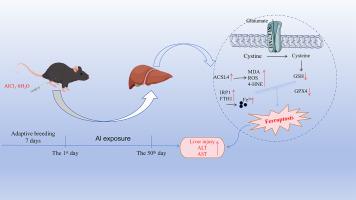氧化应激和铁稳态失衡介导alcl3诱导的小鼠肝损伤
IF 6.3
2区 环境科学与生态学
Q1 ENVIRONMENTAL SCIENCES
引用次数: 0
摘要
肝脏是一个重要的代谢器官,尤其容易受到铝的伤害。然而,铝诱导肝毒性的确切分子机制仍未完全阐明。本研究旨在探讨铝暴露对小鼠肝组织的不良影响。结果表明,AlCl3暴露可引起显著的肝功能障碍,其特征是三磷酸腺苷水平降低,血浆丙氨酸转氨酶和天冬氨酸转氨酶升高。肝组织病理分析显示明显的组织学损伤,伴大量铁沉积。进一步检查显示丙二醛、4-羟基壬烯醛和活性氧水平升高,谷胱甘肽(GSH)和超氧化物歧化酶水平降低,氧化谷胱甘肽(GSSG)水平升高,GSH/GSSG比值降低。下调的谷胱甘肽过氧化物酶4和溶质载体家族7成员11 mRNA和蛋白表达量显著下调,酰基辅酶a合成酶长链家族成员4、铁蛋白重链1和铁调节蛋白1水平显著上调。他汀-1治疗显著改善肝功能障碍和组织病理学损伤,减轻铁下垂的迹象。这些发现强调了铁中毒靶向治疗作为铝暴露诱导的肝细胞损伤的可行治疗策略的潜力。本文章由计算机程序翻译,如有差异,请以英文原文为准。

Oxidative stress and iron homeostasis imbalance mediate AlCl3-induced liver damage in mice
The liver, a critical metabolic organ, is particularly vulnerable to damage upon aluminum exposure. However, the precise molecular mechanisms through which aluminum induces hepatotoxicity remain to be fully elucidated. This study aimed to investigate the adverse effects of aluminum exposure on mouse liver tissue. The results indicated that AlCl3 exposure induced significant liver dysfunction, characterized by reduced adenosine triphosphate levels, elevated plasma alanine aminotransferase and aspartate aminotransferase. Histopathological analysis of liver tissue revealed marked histological damage, accompanied by substantial iron deposition. Further examinations demonstrated elevated hepatic levels of malondialdehyde, 4-hydroxynonenal, and reactive oxygen species, decreased levels of glutathione (GSH) and superoxide dismutase, increased levels of oxidized glutathione (GSSG), and a reduced GSH/GSSG ratio. The mRNA and protein expression of ferroptosis-related molecules, including downregulated glutathione peroxidase 4 and solute carrier family 7 member 11, were significantly downregulated, while acyl-CoA synthetase long-chain family member 4, ferritin heavy chain 1, and iron regulatory protein 1 levels were significantly upregulated. Treatment with Ferrostatin-1 markedly ameliorated liver dysfunction and histopathological damage, attenuating signs of ferroptosis. These findings highlight the potential of ferroptosis-targeted therapies as a viable treatment strategy for aluminum exposure-induced hepatocyte injury.
求助全文
通过发布文献求助,成功后即可免费获取论文全文。
去求助
来源期刊

Journal of Environmental Sciences-china
环境科学-环境科学
CiteScore
13.70
自引率
0.00%
发文量
6354
审稿时长
2.6 months
期刊介绍:
The Journal of Environmental Sciences is an international journal started in 1989. The journal is devoted to publish original, peer-reviewed research papers on main aspects of environmental sciences, such as environmental chemistry, environmental biology, ecology, geosciences and environmental physics. Appropriate subjects include basic and applied research on atmospheric, terrestrial and aquatic environments, pollution control and abatement technology, conservation of natural resources, environmental health and toxicology. Announcements of international environmental science meetings and other recent information are also included.
 求助内容:
求助内容: 应助结果提醒方式:
应助结果提醒方式:


